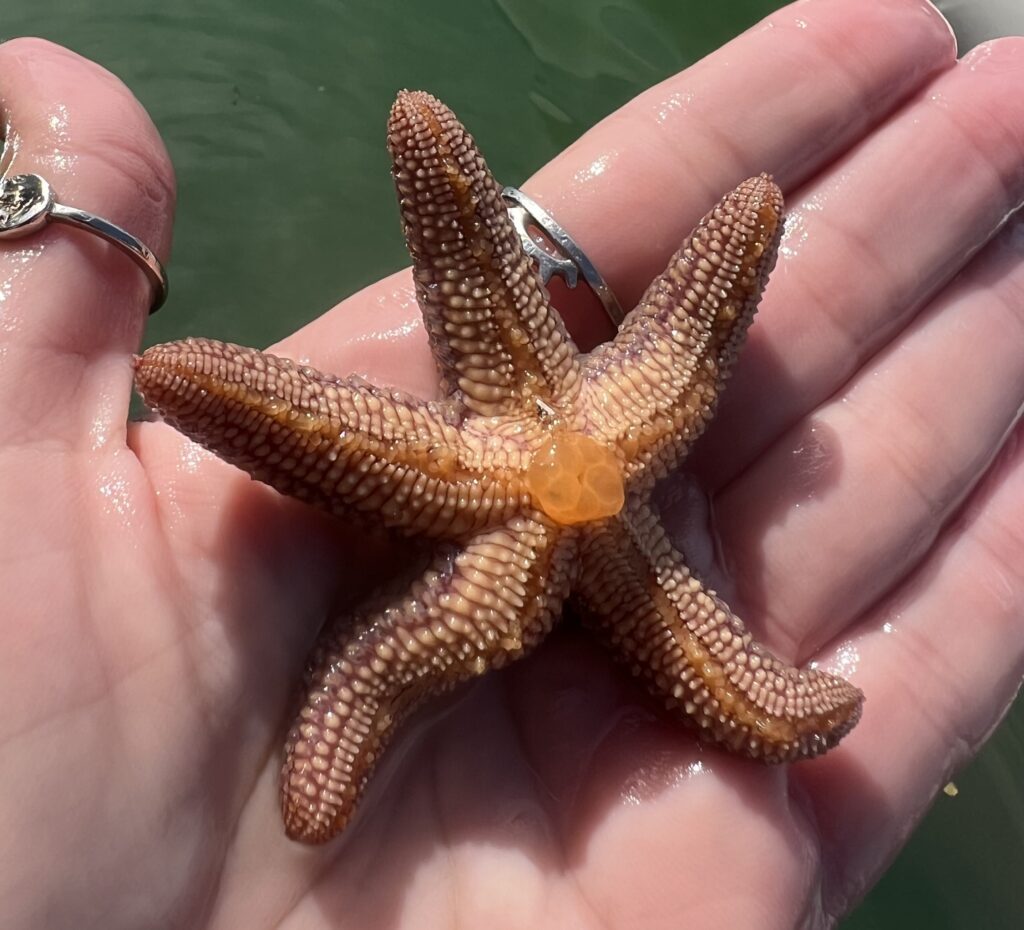The Forbes sea star Asterias forbesi

In December, there have been several occasions where I came across Asterias forbesi, the Forbes sea star.
Forbes sea stars are known as the common “sea star” and are found in the littoral zones of the North American Atlantic and the Gulf of Mexico. They do not live in colonies, but they can be found in abundance, especially in the winter months, because that is when sea stars reproduce. Their spiny skin can be tan, brown or olive with hints of pink, orange, or red and range in sizes from 7 to15 centimeters.
This coloring can make them easy to spot when looking for them. I was able to find five sea stars on Christmas eve morning that had attached themselves to the trestles so that they could snack on the crustaceans. One of the smaller ones even had its stomach extended out, ready to eat. Sea stars don’t have an internal digestive system or a real mouth. Instead, their stomach extends from the underside of the central disk. The stomach then envelops the food and digests it outside of the body.

As is the case with other sea creatures, there is always misinformation and misunderstanding that floats around. As a Florida Master Naturalist, I work diligently to understand the natural world and pass it on to the public to inspire connection, conservation and protection. Sea stars are always a big topic, especially at this is the time of year.
Sea stars are what most people refer to as starfish. However, biologically they are not fish. They are in the class of Echinodermata, spiny-skinned animals that live only in the oceans, with about 7,000 living species and 13,000 extinct ones. A few common local echinoderms besides sea stars are urchins, sand dollars, brittle stars and sea cucumbers.
Rather than gills like fish, sea stars have a water vascular system, a network of fluid-filled tubes that helps them move, breathe and sense their environment. In a feat that modern medicine has only recently mastered, sea stars and other echinoderms can use stem cells to regenerate damaged or broken limbs, spines and vital organs, making them a hardy animal.
Sea stars live in the extreme marine ecosystem that is referred to as an intertidal zone, the area that fluctuates between low and high tides, with some tides being so low there is no water in many areas. To be able to survive and thrive in this unforgiving habitat, most sea star species have adapted to surviving without water for a long period of time. This is one of the most common misconceptions I educate people on concerning our local sea stars. Many people believe that they can only live without water for 30 seconds, which would pose a serious threat to the existence of this species if it were true.
The truth is that, depending on the species and conditions, some sea stars can live more than 24 hours out of water. This is a necessity in intertidal zones such as the area of the Gasparilla shorelines I paddle around most frequently, particularly in the winter months when we have frequent negative tides. Negative tides are so low that sandbars and some grass flats go hours with no water, sometimes twice a day depending on how many tidal exchanges we have in that 24-hour period. Sea stars survive these negative tides by storing water in their bodies and use it to keep their vital organs moist, as well as moving to tide pools and deeper areas if possible.
Even though sea stars are hardy creatures and can live without water for some time, it is still important that we humans respect them and their role in the local ecology. It is never OK to remove them from the water just to play with them or to take them home.
Instead, it is best to observe them without interfering with them, unless you are handling them with caution and for only a few moments. Then place them gently right back where they were. And never place them with their tube feet down, because they can attach to your skin and tear off pieces of your epidermis.









